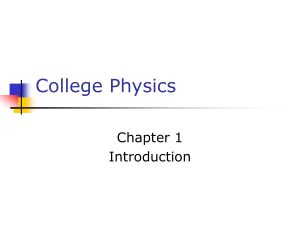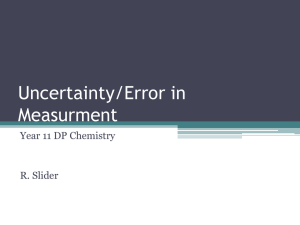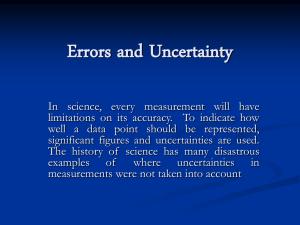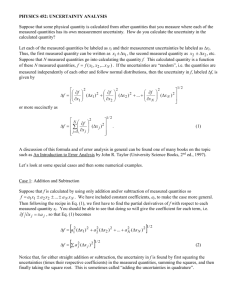College Physics
advertisement
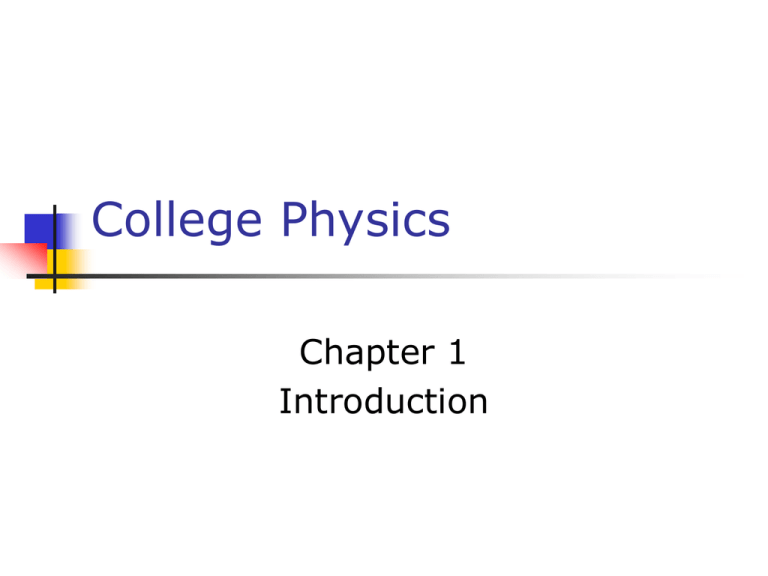
College Physics
Chapter 1
Introduction
Theories and Experiments
The goal of physics is to develop
theories based on experiments
A theory is a “guess,” expressed
mathematically, about how a system
works
The theory makes predictions about
how a system should work
Experiments check the theories’
predictions
Every theory is a work in progress
Fundamental Quantities
and Their Dimension
Length [L] meters
Mass [M] kilograms
Time [T] seconds
other physical quantities can be
constructed from these three
These are called derived units with
examples of velocity, m/s, force;kgm/s2
Units
To communicate the result of a
measurement for a quantity, a unit
must be defined
What is a gram? How long is a meter?
Defining units allows everyone to
relate to the same fundamental
amount
How is a second defined?
Systems of Measurement
Standardized systems
agreed upon by some authority, usually a
governmental body
SI -- Systéme International
agreed to in 1960 by an international
committee
main system used in this text
also called mks (meter, kilogram, second)
for the first letters in the units of the
fundamental quantities
Systems of
Measurements, cont
cgs – Gaussian system
named for the first letters of the units
it uses for fundamental quantities
Centimeter, gram, second
US Customary
everyday units
often uses weight, in pounds, instead
of mass as a fundamental quantity
Length
Units
SI – meter, m
cgs – centimeter, cm
US Customary – foot, ft
Defined in terms of a meter – the distance
traveled by light in a vacuum during a given
time of 1/299792458 second. This establishes
the speed of light at 299792458 m/sec or its
accepted value of 3.00 x 108 m/s.
Mass
Units
SI – kilogram, kg
cgs – gram, g
USC – slug, slug
Defined in terms of kilogram, based on a
specific cylinder of platinum and iridium alloy
kept at the International Bureau of Weights
and Measures located in Sevres, France.
Standard Kilogram
Time
Units
seconds, s in all three systems
9192631700 times the period of
oscillation of radiation from a cesium
atom
The current standard cesium clock was
built and is housed at the National
Institute of Standards and Technology
Laboratory in Boulder, Colorado
Approximate Values
Various tables in the text show
approximate values for length,
mass, and time: See Page 3
Note the wide range of values
Lengths – Table 1.1
Masses – Table 1.2
Time intervals – Table 1.3
Prefixes
Prefixes correspond to powers of 10
Each prefix has a specific name
Each prefix has a specific abbreviation
See table 1.4 found on page 4
Common prefixes
109 giga, G
101 deka, da
10-3 milli, m
to remember:
106
mega, M
10-1 deci, d
10-6 micro,
103
10-2
10-9
kilo, k
centi, c
nano, n
Structure of Matter
Matter is made up of molecules
the smallest division that is identifiable as a
substance
Bodies of mass smaller than the molecule
will not have characteristics of a unique
substance; e.g. protons, neutrons, electrons
Molecules are made up of atoms
correspond to elements
More structure of matter
Atoms are made up of
nucleus, very dense, contains
protons, positively charged, “heavy”
neutrons, no charge, about same mass
as protons
protons and neutrons are made up of quarks
orbited by
electrons, negatively charges, “light”
fundamental particle, no structure
Structure of Matter
Structure of Matter
Quarks – up, down, strange, charm,
bottom, and top.
Up, Charm, and Top have a charge of
+ ⅔ that of a proton.
Down, Strange, and Bottom have a
charge of - ⅓ that of a proton.
The proton has two up quarks and one
down quark. ⅔ + ⅔ - ⅓ = + 1.
The neutron has two down quarks and
one up quark. - ⅓ - ⅓ + ⅔ = 0.
The other quarks are indirectly
observed and not well understood.
Dimensional Analysis
Technique to check the correctness
of an equation
Dimensions (length, mass, time,
combinations) can be treated as
algebraic quantities
add, subtract, multiply, divide
Both sides of equation must have
the same dimensions
Dimensional Analysis,
cont.
Cannot give numerical factors: this is its
limitation
Dimensions of some common quantities are
listed in Table 1.5 on page 5.
Example: [a] = [v]/[t]; L/T = {x}/{t2}
T
a = x/t2
x = at2
Uncertainty in
Measurements
There is uncertainty in every
measurement, this uncertainty carries
over through the calculations
need a technique to account for this
uncertainty
We will use rules for significant figures
to approximate the uncertainty in
results of calculations
Significant Figures
A significant figure is one that is reliably
known
All non-zero digits are significant
Zeros are significant when
between other non-zero digits
after the decimal point and another
significant figure
can be clarified by using scientific notation
Operations with Significant
Figures
When multiplying or dividing two or
more quantities, the number of
significant figures in the final result is
the same as the number of significant
figures in the least accurate of the
factors being combined
Operations with Significant
Figures, cont.
When adding or subtracting, round the
result to the smallest number of
decimal places of any term in the sum
If the last digit to be dropped is less
than 5, drop the digit
If the last digit dropped is greater than
or equal to 5, raise the last retained
digit by 1
Examples of Significant Digits
Addition & Subtraction – The resulting
answer is to have the same degree of precision as
the least precise number used in the calculation.
Ex. 3.6 – 0.57 = 3.0 not 3.03
5.4 + 2.35 = 7.8 not 7.75
Multiplication & Division - The resulting answer
is to have the same number of significant digits as
the number with the least precise number of
significant digits.
Ex.
2.0 ÷ 3.0 = 0.67 not 0.6666666666
2.5 x 3.2 = 8.0 not 8
Reading Quiz
The quantity 2.67 x 103 m/s has how many significant figures?
A.
1
B.
2
C. 3
D. 4
E.
5
Answer
The quantity 2.67 x 103 m/s has how many significant figures?
A.
1
B.
2
C. 3
D. 4
E.
5
Slide 1-8
Importance of Measurements
Data collection and interpretation are
essential skills in physics
Repeatability to obtain measurements and
the degree of uncertainty of correctness are
very important
Importance of Measurements
Precision – The repeatability of the
measurement using a given instrument
Example:
If a board is measured four times and the results are
8.81 cm, 8.78 cm, 8.85 cm, 8.82 cm then the
precision of the measurement is ± 0.1 cm.
The value beyond the 0.1 cm level is an estimate
between 8.8 and 8.9 cm.
Importance of Measurements
Accuracy
– The degree of closeness a
measurement is to the true and correct
value.
Example:
If the ruler used to take the
measurements stated previously was
manufactured with a 2% error, the
accuracy of the 8.8 cm measurement
would be 2% or 8.8 x 0.02 = ± 0.176
cm or ± 0.2 cm .
Importance of Measurements
Estimated Uncertainty – Expressing the
measurement with the degree of
determined precision of the measurement
Example:
8.8 ± 0.1 cm is the estimated uncertainty because
the measurement was 8.8 cm and the level of
precision was determined to be ± 0.1 cm
Importance of Measurements
Percent Uncertainty – The ratio of the
uncertainty of the measured value to the
measured value multiplied by 100.
Example:
Uncertainty → 0.1 cm
Measured value → 8.8 cm
% uncertainty = (0.1/8.8) x 100 = 1%
Importance of Measurements
Percent uncertainty Example - A family heirloom
diamond is loaned to a friend to show her family. Before
giving her the diamond you weigh it and get 8.17 g on a
scale of ± 0.05g accuracy. Upon return the diamond
weighs 8.09 g. Is this your diamond?
Answer – The mass before release was 8.17± 0.05g
meaning the weight range was 8.12 – 8.22 g. The
mass after return was 8.09 ± 0.05g meaning the
weight range was 8.04 – 8.14 g. Since these ranges
overlap (8.12 – 8.14) there is no concern about
discrepancy.
Percent Error
The calculation of % error from the determined
data is an integral part of the analysis of physics.
% error = |accepted value – measured value|x 100
accepted value
Example: Determination of gravity
Measured value
9.68 m/s 2
Accepted value
9.80 m/s 2
% error = 9.80 – 9.68 x 100 = 1.22%
9.80
Mean, Variance, & Standard
Deviation
The mean, x is the average of the
measured values divided by the
number of values.
2
( x x)
2
2
The variance, , equals
.
n 1
The standard deviation of the
measurements equals , or the square
2
root of the variance.
( x x)
n 1
Example of Statistical
Analysis
You are measuring the time needed for a frictionless car to
go down a fixed ramp that has a length of 1.45 meters
that is set at an angle so that you attempt to determine
the value of the gravity constant. The measurements
are taken on six test runs with the following results.
Determine the mean value of g; determine the variance
and standard deviation of your measurements and
explain what the results tell you about the value that
you determine for g.
Example of Statistical
Analysis
Prepare a table with all of the
necessary data and calculations.
Remember that acceleration is
equal to: a=v/t; v=x/t;
s
t
m/s
v
m/s
x
a t , or
t
x
a 2
t
2
g
(g – g’) (g – g’)2
0.36s
4.03
11.19
1.39
1.93
0.40s
3.63
9.06
-0.74
0.55
0.38s
3.82
10.04
0.24
0.06
0.37s
3.92
10.59
0.79
0.62
0.39s
3.72
9.53
-0.27
0.07
0.40s
3.63
9.06
-0.74
0.55
Example of Statistical
Analysis
s
t
m/s
v
m/s
g
2
(g – g’)
(g – g’)2
0.36s
4.03
11.19
1.39
1.93
0.40s
3.63
9.06
-0.74
0.55
0.38s
3.82
10.04
0.24
0.06
0.37s
3.92
10.59
0.79
0.62
0.39s
3.72
9.53
-0.27
0.07
0.40s
3.63
9.06
-0.74
0.55
g=
(11.19+9.06+10.04+10.59+9.53+9.06)
g’=9.80 m/s2
= 9.91 m/s2
6
(1.93 0.55 0.06 0.62 0.07 0.55) 3.78
(g g)
2
0.76
n 1
6 1
5
2
0.76 0.87
Example of Statistical
Analysis
The data demonstrated that our measurement for the value of
g was only 0.11m/s2 away from the accepted value. This was
good accuracy.
The standard deviation of 0.87 means that our data within the
range of (8.93 to 10.67) was 68.3% certain to contain the
correct value. This is one standard deviation away from the
value, 9.80.
The percent error is (|9.91 – 9.80|/9.80)x100% = 1.12%
Summary of Formulas
Accuracy – (measurement) x (% error of device)
Precision – one power of ten less than the given measurements
Estimated uncertainty – measurement accepted level of
precision
Percent Uncertainty –
% uncertainty = uncertainty x 100
measurement
Percent error –
% error = |accepted value – measured value| x 100
accepted value
Sample Problems
What is the % uncertainty in the
measurement 3.76 0.25?
Answer: (0.25/3.76) x 100% = 6.6%
What is the % uncertainty in the measurement 11.3
0.9?
Answer: (0.9/11.3) x 100% = 8%
Sample Problems
In calculating the area of a piece of notebook paper
you get measurements of (21.1 .1) cm for the
width and (27.5 .2) cm for the length. Determine
the area and the uncertainty. If the actual value of
the area is 603 cm2, determine the percent error
from your calculation.
measurements
Measurements x uncertainties
of other measure
Uncertainty x
uncertainty
Answer: (21.1)(27.5) {(21.1)(.2) + (27.5)(.1) + (.1)(.2)} =
580.25 (4.22 + 2.55 + 0.02) = (580 7) cm2
% error = (603 – 580) x 100 = 3.8%
603
Sample Problems
An airplane travels at 950 km/h. How long in
seconds does it take to travel 1 km?
Answer: (950 km/h)(1h/3600sec) = .26 km/sec; t= 1 km/.26 km/s = 3.8 s
Use dimensional analysis to determine if the equation
vf 2 = vo 2 + 2as is consistent.
Answer: [L]2 = [L]2 + [L][L]
[T]2
[T]2 [T]2
[L]2 = [L]2
[T]2
[T]2 The equation is consistent.
Conversions
When units are not consistent, you may
need to convert to appropriate ones
Units can be treated like algebraic
quantities that can “cancel” each other
See the inside of the front cover for an
extensive list of conversion factors
Example:
2.54 cm
15.0 in
38.1 cm
1 in
Examples of various units
measuring a quantity
Order of Magnitude
Approximation based on a number of
assumptions
may need to modify assumptions if more
precise results are needed
Order of magnitude is the power of 10
that applies
Examples: 27~30, 1006950~1000000
Coordinate Systems
Used to describe the position of a
point in space
Coordinate system consists of
a fixed reference point called the
origin
specific axes with scales and labels
instructions on how to label a point
relative to the origin and the axes
Types of Coordinate
Systems
Cartesian – (x,y) or (x,y,z)
Plane polar - (r,)
y
s
r
x
Cartesian coordinate
system
Also called
rectangular
coordinate
system
x- and y- axes
Points are labeled
(x,y)
Plane polar coordinate
system
Origin and
reference line are
noted
Point is distance r
from the origin in
the direction of
angle , ccw from
reference line
Points are labeled
(r,)
Trigonometry Review
opposite side
sin
hypotenuse
adjacent side
cos
hypotenuse
opposite side
tan
adjacent side
More Trigonometry
Pythagorean Theorem
2
2
2
r x y
To find an angle, you need the
inverse trig function
1
0.707 45
for example, sin
Be sure your calculator is set
appropriately for degrees or
radians
Problem Solving Strategy
Problem Solving Strategy
Read the problem
Identify the nature of the problem
Draw a diagram
Some types of problems require very
specific types of diagrams
Problem Solving cont.
Label the physical quantities
Can label on the diagram
Use letters that remind you of the quantity
Many quantities have specific letters
Choose a coordinate system and label it
Identify principles and list data
Identify the principle involved
List the data (given information)
Indicate the unknown (what you are looking
for)
Problem Solving, cont.
Choose equation(s)
Based on the principle, choose an
equation or set of equations to apply
to the problem
Substitute into the equation(s)
Solve for the unknown quantity
Substitute the data into the equation
Obtain a result
Include units
Problem Solving, final
Check the answer
Do the units match?
Does the answer seem reasonable?
Are the units correct for the quantity
being found?
Check order of magnitude
Are signs appropriate and
meaningful?
Problem Solving Summary
Equations are the tools of physics
Carry through the algebra as far as
possible
Understand what the equations mean
and how to use them
Substitute numbers at the end
Be organized
Homework Assignment
Pages 19 – 22
Problems: 5, 7, 8, 11, 17, 21, 31,
41, 42, 52.
